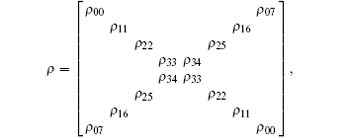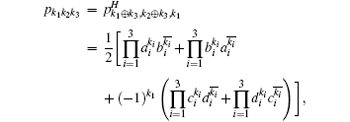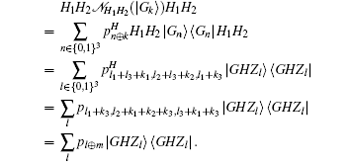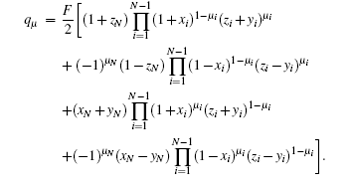†Corresponding author. E-mail: xychen@mail.zjgsu.edu.cn
*Project supported by the National Natural Science Foundation of China (Grant No. 11375152).
An N-qubit Greenberger–Horne–Zeilinger (GHZ) state has many applications in various quantum information tasks and can be realized in different experimental schemes. A GHZ diagonal state evolves to another GHZ diagonal state in independent parallel Pauli channels. We give the explicit expression of the resultant GHZ diagonal state in terms of the initial state and channel parameters. If the initial state is a pure N qubit GHZ state or a three-qubit GHZ diagonal state admits a condition, the full separability criterion of the Pauli noisy state is equivalent to positive partial transpose (PPT) criterion. Thus the fully separable condition follows.
Quantum entanglement plays a fundamental role in quantum information science. Multipartite entanglement provides a critical resource for quantum secret sharing, quantum error-correcting codes and quantum computation.[1, 2] Experimentally, multipartite entanglement has been observed in ion traps, [3] photon polarization, [4] superconducting phase and circuit qubit systems, [5] and nitrogen-vacancy centers in diamond.[6] All of these experiments center at preparing graph states, including the GHZ states as special cases. A graph state will become a graph diagonal state in a Pauli environment.[7, 8] One of the key issues is to determine whether the GHZ states contaminated by Pauli environment is genuinely entangled or not entangled at all. The action of a general physical decoherece process on an initial density operator ρ can be described by Λ (ρ ), where Λ is a completely positive trace-preserving map. All such maps can be expressed in a Kraus representation, 

In this paper, we will study the change of an N-qubit GHZ state or a three-qubit GHZ diagonal state passing through independent parallel Pauli channels. The full separability and biseparability of the resultant GHZ diagonal states are analyzed.
The three-qubit GHZ diagonal states take the form

where the pm form a probability distribution. The GHZ state basis consists of eight vectors

with xi,

where ρ 00, ρ 07 = (p0 ± p7)/2; ρ 11, ρ 16 = (p1 ± p6)/2; ρ 22, ρ 25 = (p2 ± p5)/2; ρ 33, ρ 34 = (p3 ± p4)/2.
Using Pauli matrices X, Y, Z, and 2 × 2 identity matrix I, the GHZ diagonal states can be written as

where tensor product symbols are omitted. The parameters λ i are


where H′ is a 4 × 4 Hadamard matrix. Denote

then κ = (1 + λ − )/8, with λ − = min{λ 1 + λ 2 + λ 3, λ 1 – λ 2 – λ 3, – λ 1 + λ 2 – λ 3, – λ 1 – λ 2 + λ 3}, and λ − is never positive. So

When 

Under the condition 


which has a more clear physical meaning that the minimal diagonal element of the density matrix is no less than the maximal absolute value of the off-diagonal element. When 
The biseparable criterion for a GHZ diagonal state ρ is[9]

A graph G = (V, Γ ) is composed of an N vertex set V and an edge set specified by the adjacency matrix Γ , which is an N × N symmetric matrix with vanishing diagonal entries and Γ ab = 1 if vertices a, b are connected and Γ ab = 0 otherwise. The neighborhood of a vertex a is denoted by Na = {v ∈ V| Γ av = 1}, that is, the set of all the vertices that are connected to a. The graph state related to graph G is defined as

where | μ 〉 is the joint eigenstate of Pauli operators Za (a ∈ V) with eigenvalues (− 1)μ a. It can be shown that the graph state is the joint + 1 eigenstate of the N vertex stabilizers

The N commutative vertex stabilizers are generators of an Abelian group K. The group is called the stabilizer group of the graph state | G〉 . Every element Ks ∈ K stabilizes | G〉 such that Ks | G〉 = | G〉 .
A qubit Pauli channel is described by Kraus operators 

for input state ρ . We characterize the channel by a parameter vector (x, y, z) = (px, py, pz)/f. Let us consider a local Clifford group which is defined to consist of all local unitary operators mapping the Pauli group to itself under conjugation. There are two basic local Clifford operators, one is the Hadamard gate H, the other is the phase gate P. Up to a global phase factor, any one-qubit Clifford operation is a product of operators chosen from the set {H, P}, where

For a single qubit unitary gate U, consider the channel ℰ U = U† ○ ℰ ○ U, (here ‘ ○ ’ denotes the successive applications of the gate or channel) we have

with X′ = U† XU, Y′ = U† YU, Z′ = U† ZU. Hence ℰ H(ρ ) = fρ + pxZρ Z + pyYρ Y + pzXρ X, for HZH = X. Thus the channel ℰ H is characterized by the vector (z, y, x). Similarly, for phase gate P, we have ℰ P(ρ ) with characteristic vector (y, x, z). The local complementary transform is an essential tool in graph state theory. For a graph G and its vertex a, the local complementary operator is

We have ℰ Ua(ρ a) with characteristic vector (x, z, y) for qubit a, and ℰ Ua(ρ b) (b ∈ Na) with characteristic vector (y, x, z) for the neighborhood of a.
For two local Clifford equivalent graph states as inputs to parallel Pauli channels, we obtain one output state from another by a proper permutation of the elements of the characteristic vectors. Thus one only needs to study one of the local Clifford equivalent graph states.
For N parallel Pauli channel array 

with 



where μ = (μ 1, μ 2, … , μ N) is a binary string, 

According to the orthogonality of graph state bases, 〈 G| Zμ Eα | G〉 = 0 except Zμ Eα ∈ K up to phase factors ± 1, ± i. Hence

The three-qubit GHZ state 
Notice that the number of Pauli operators is 43 for a three-qubit state. The operators in Table 1 exhaust all the 64 Pauli error operators. We classify the error operators in Table 1 according to the stabilizer group K. An error operator Eα may belong to the stabilizer group K or its cosets in the Pauli group. The coset heads are specified by Zμ . We then get the density matrix of the output state according to Eq. (17). Consider the parallel Pauli channels with different parameters, namely 


where (xi, yi, zi) = (pxi, pyi, pzi)/fi. fi = 1 − pxi − pyi − pzi are the channel parameters for the i-th qubit. In a more systematical way, 
| Table 1. Pauli operators classified as stabilizer group and its cosets. In the table, ‘ St’ stands for ‘ Stabilizers’ , and ‘ Co’ stands for ‘ Cosets’ of the stabilizer group. |
Consider the channel 

Denote 

Where we have used the fact that Hadamard transformations on the first and second qubits interchange their channel parameters of bit flipping and phase flipping, namely, xi ⇔ zi (i = 1, 2). Denote ai = fi + pzi, bi = pxi + pyi, ci = fi − pzi, di = pxi − pyi, (i = 1, 2, 3), then

Similarly,

where

for the output state

we have

where 


for m = 2k2 + k3 ≤ 3. We write the output state 

then we have

and




Hence

For any GHZ diagonal state with 
Consider the separability of a noisy GHZ state. For an initial GHZ state

after passing through the parallel Pauli channels the output state 

For identical Pauli channels with pxi = px, pyi = py, pzi = pz, (i = 1, 2, 3), the fully separable criterion reduces to ab ≥ | c3 + d3| , where a = f + pz, b = px + py, c = f − pz, d = px − py, and f = 1 − px − py − pz. Namely

where p± = px ± py. The border of the regions of full separability and entanglement is shown in Fig. 1.
For identical depolarizing channels we have px = py = pz = p, the full separable criterion reduces to

The biseparable criterion (9) now reduces to 3ab ≥ | c3 + d3| , namely

The border of the regions of biseparability and genuine entanglement is shown in Fig. 2.
For identical depolarizing channels, the biseparable criterion reduces to

Consider the input state of GHZ diagonal state ρ = ∑ mqm| GHZm〉 〈 GHZm| = H1H2∑ mqm| Gk〉 〈 Gk| H1H2, where the binary string m = (m1, m2, m3)∈ {0, 1}3, the binary string k = (m1 ⊕ m3, m2⊕ m3, m1). The output state of parallel Pauli channel 

For every input of graph basis state | Gk〉 , the output of channel 


Thus

Where Pl = ∑ mqmpm⊕ l. In computational basis, we have 


for n = 0, … , 3. Define

then

Similarly, we have 

We have proved that 


Define 


for the input state of a GHZ diagonal state (2), with relationships of


In the operator representation of the input and output states, the effect of the Pauli channel on GHZ diagonal state is simply characterized by the decay of the parameters.
In graph state basis, an N-qubit GHZ state | G〉 is stabilized by the following mutual commutating stabilizer operators

that is, Kj| G〉 = | G〉 , the GHZ state | G〉 is the common eigenstate of all these stabilizer operators Kj with eigenvalues being + 1. Here Xj, Zj are the Pauli X and Z matrices applied to the j-th qubit. The N-qubit GHZ state is

where 


where 

in terms of stabilizer operators, where

and μ , ν ∈ {0, 1}⊗ N. Inversely,

Clearly, we have the trace of the state to be s0 = ∑ μ qμ = 1 and the minimal eigenvalue of ρ should be non-negative, so

Consider the application of the Pauli channel 


For the error operator Eα ∈ K, the input state | G〉 is not changed by the error Eα since K is the stabilizer of | G〉 . The probability of | G〉 after the channel application is the probability of error operator Eα belonging to the stabilizer K. We have

where 0 = (0, … , 0) is the binary string with all elements nullified. We should summarize the corresponding η α for Eα ∈ K. For the stabilizer operator Kμ with μ N = 0, the contribution to the probability q0 is 

where 

In general, the probability qμ of obtaining the state | Gμ 〉 when sending the N-qubit GHZ state | G〉 through a parallel Pauli channel is

After some algebra, and denoting

we have sμ for μ N = 0 and μ N = 1,

respectively, where aN, cN = fN ± pzN; bN, dN = pxN ± pyN; ai, ci = fi ± pxi; bi, di = pzi ± pyi, (i = 1, … , N − 1).
The sufficient condition for the coincidence of the full separability and the PPT criterion of the GHZ diagonal state ρ is that there is δ ∈ {0, 1}⊗ (N− 1) such that ∀ ξ ∈ {0, 1}⊗ (N− 1), [11]

We will prove that inequality (41) is true for the N-qubit GHZ diagonal state ρ obtained by passing N-qubit GHZ state | G〉 through the parallel Pauli channel. When ξ = 0· · · 0, the left side of inequality (41) is sign(s0· · · 01)s0· · · 01, which is no less than 0. For any ξ with weight 1 (the number of 1 in the N − 1 bit string), say ξ i = 1 and all the other bits are 0, it is always possible to choose δ i such that

where s(i) = s0· · · 010· · · 01, the subscript is an N-bit string with i-th bit and N-th bit being 1 and all the other bits being 0.

For ξ = 1· · · 10· · · 0, the weight of ξ is i, the first i bits are 1, the rest bits are 0. When i is odd, we have

Then

using inequality (42), we arrive at

When i is even, we have

We also arrive at expression (44) by using inequalities (42) and (45).
By interchanging the qubits, we can prove inequality (41) for any string ξ of weight i and length N − 1. By varying i from 2 to N – 1, the inequality (41) can be proved. Hence the fully separable condition for an N-qubit GHZ state damped by Pauli noise coincides with the PPT criterion. The fully separable condition is[11] (which can also be obtained from the PPT criterion by choosing the proper bipartition)

For an identical depolarizing channel, pxi = pyi = pzi = p, the condition (46) is reduced to

for even N, and

for odd N.
The evolution of an N-qubit GHZ state in the Pauli environment is studied. For a three-qubit GHZ state, the Pauli noise contaminated GHZ state is a genuine-entangled state when the Pauli noise is weak (the noise parameter p < 0.071149 for depolarizing channel). It becomes biseparable when the Pauli noise is strong (0.110827 > p ≥ 0.071149 for depolarizing channel). It becomes fully separable when the Pauli noise is more strong (p ≥ 0.110827 for depolarizing channel). The full separability criterion of a Pauli noisy three-qubit GHZ state is proved to be equivalent to PPT criterion. It is determined by comparing the minimum diagonal element with the maximal anti-diagonal element of the density matrix in computational basis. We have also proved that the equivalence of the full separability criterion and PPT criterion for an N-qubit GHZ state contaminated by any parallel Pauli noise. The condition for full separability of a Pauli noisy N-qubit GHZ state is obtained.
| 1 |
|
| 2 |
|
| 3 |
|
| 4 |
|
| 5 |
|
| 6 |
|
| 7 |
|
| 8 |
|
| 9 |
|
| 10 |
|
| 11 |
|
| 12 |
|
| 13 |
|
| 14 |
|
| 15 |
|
| 16 |
|
| 17 |
|




